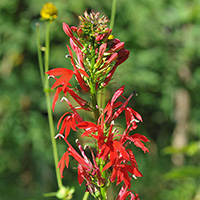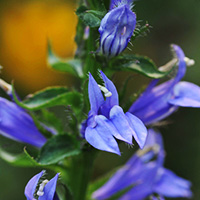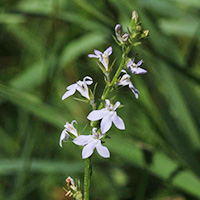BONAP : 51 species of Lobelia in the U.S. with 5 species of Lobelia native to Iowa.
The genus Lobelia is one of eighty four genera in the Campanulaceae (Bell Flower) family of plants. Members of this family are mostly perennial herbs containing a milky sap, alternate leaves, perfect flowers, and 5-lobed actinomorphic calyces. The family has been divided into two subfamilies: Campanuloideae which have radially symmetric flowers (actinomorphic) and Lobelioideae which have bilaterally symmetric (zygomorphic) flowers. The latter subfamily includes Lobelia. If you want to dive more deeply into details about this family, check the list of publications on the website by Dr. Thomas Lammers.
Lobelia species, characteristically, have zygomorphic flowers with two petals—the upper petal with two lobes and the lower petal with three lobes. The two carpelate ovaries produce capsules which open by apical valves and release large numbers of small seeds. For the Iowa species of Lobelia, L. cardinalis is pollinated by hummingbirds (and possibly hawk months), and the four other Lobelia species are pollinated primarily by bees.
Secondary Pollen Presentation
The family Campanulaceae, which includes the genus Lobelia, is one of sixteen plant families with members that have evolved a mechanism for secondary pollen presentation. The first method of pollen presentation is very common and is simply to leave the pollen on the open anthers; but, a few plants have developed another method—called secondary pollen presentation—in which the pollen is moved to a site more accessable to a pollinator. This is believed to improve the efficiency of pollen distribution and to make outcrossing more likely, and "selfing" less likely, to occur.Nine mechanisms for "secondary pollen presentation" have been described by Howel et al. 1993. The sixth mechanism would apply to Lobelia. The Lobelia mechanism was also described by Leins and Erbar 1989 who called it a pump—it works as follows: Lobelia species have five filaments with their attached anthers. These are fused to form a filament tube and anther tube which together form a cylinder around the style and the stigmatic structure at its tip. At the base of the stigmatic structure is a collar (or ring) of "brush" hairs. The sensitive stigmatic surface is not yet developed and is protected by its closed bivalve structure. When the pollen is ready, it is released into the anther tube—where it is not easily accessible to pollinators. The growing style pushes the stigmatic structure, with its brush-like collar, through the tube. This pushes the pollen to the end of the anther tube where a small orifice allows a slow exit of the pollen. This would be the secondary presentation of the pollen. Additionally, some Lobelia species have a tuft or "beard" of hairs just below the exit oriface. A suggested role of the "beard" is to adjust the orifice and regulate the rate at which pollen is released when a pollinator brushes against it. Self-pollination is unlikely to occur in the anther tube because the stigmatic surface remains covered and unreceptive.
After the pollen has been pushed from the cylinder and blown away or carried away by pollinators, the style continues to elongate, pushing the stigmatic structure out of the downturned anther tube. This positions it to brush against any pollinators when they visit for nectar. Upon drying the stigmatic structure opens, exposing a two lobed stigma which is now receptive to the pollen provided by pollinators as they feed on the plants nectar. Self-pollination has been reported for several Lobelia species usually with the caveat that the percentage is small and that the fruit set is less viable than that derived from outcrossed pollination.
The five Iowa species of Lobelia
 Lobelia cardinalis - Cardinal flower
Lobelia cardinalis - Cardinal flower
 Lobelia siphilitica - Great blue labelia
Lobelia siphilitica - Great blue labelia
 Lobelia spicata - Palespike lobelia
Lobelia spicata - Palespike lobelia
 Lobelia inflata - Indian-tobacco
Lobelia inflata - Indian-tobacco